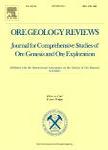版权所有:内蒙古大学图书馆 技术提供:维普资讯• 智图
内蒙古自治区呼和浩特市赛罕区大学西街235号 邮编: 010021

作者机构:Xinjiang Inst Ecol & Geog Chinese Acad Sci State Key Lab Desert & Oasis Ecol Urumqi 830011 Peoples R China Xinjiang Key Lab Mineral Resources & Digital Geol Urumqi 830011 Peoples R China Chinese Acad Sci Xinjiang Res Ctr Mineral Resources Urumqi 830011 Peoples R China Univ Chinese Acad Sci Beijing 100049 Peoples R China Univ Ghent B-9000 Ghent Belgium Sino Belgian Joint Lab Geoinformat B-9000 Ghent Belgium Sino Belgian Joint Lab Geoinformat Urumqi 830011 Peoples R China Chinese Acad Sci Technol & Engn Ctr Space Utilizat Beijing 10094 Peoples R China Chinese Acad Sci Xinjiang Inst Ecol & Geog Xinjiang Res Ctr Mineral Resources Urumqi 830011 Peoples R China
出 版 物:《ORE GEOLOGY REVIEWS》 (矿物地质学评论)
年 卷 期:2024年第165卷
核心收录:
学科分类:0819[工学-矿业工程] 0709[理学-地质学] 08[工学]
基 金:Science and Technology Major Project of the Xinjiang Uygur Autonomous Region, China Third Xinjiang Scientific Expedition Program [2021A03001-3] Chinese Academy of Sciences Strategic Leading Science and Technology Special Project 2022xjkk1306
主 题:Hyperspectral remote sensing Cu element Continuum removal method Gradient Boosting Regression Tree Inversion accuracy
摘 要:The inversion of Cu contents in rocks based on hyperspectral remote sensing is indicative of geochemical exploration as well as mineral resource exploration. Due to the strong redundancy of band information in hyperspectral data, characteristic band selection is the key to improving the accuracy of metal element inversion models in hyperspectral data. In this study, we proposed a framework that innovatively focuses on secondary screening method (SSM) as the core, allowing users to add different data preprocessing methods and machine learning algorithms to the framework based on expert experience, to obtain high-precision metal element inversion models suitable for sampling data. we first preprocessed the measured spectral curves using the first order derivative, second order derivative, continuum removal, multiple scattering correction and variance analysis to highlight band absorption characteristics. In addition, we performed SSM to obtain Cu-related characteristic bands, which were further used as input data to train and compare the performance of Partial Least Square Regression (PLSR), Support Vector Regression (SVR), Multi-Layer Perceptron (MLP), Random Forest (RF) and Gradient Boosting Regression Tree (GBRT). The results show that both the spectral pretreatment and modeling method could potentially impact the inversion accuracy. The accuracy of the ensemble method applied in fresh faces data (i.e., a CR-SSM-RF with R2 values of 0.77 and CR-SSM-GBRT with R2 values of 0.81) performed better than other models with an accuracy improvement of up to 80%. Compared to the full band model, the accuracy of characteristic bands selection model increased 50%. This also illustrates that the CR-SSM-RF or CRSSM-GBRT model significantly improves the accuracy of the inversion of Cu contents in rocks compared to the original spectral reflectance. Our study provides a new idea for selecting different spectral preprocessing methods as the input values for the future model and wil